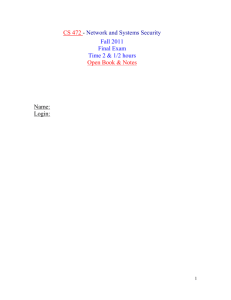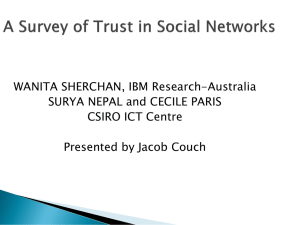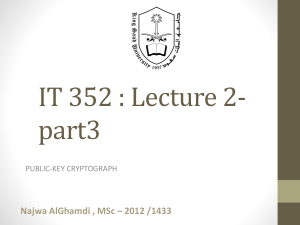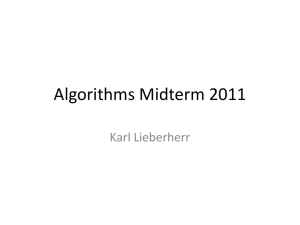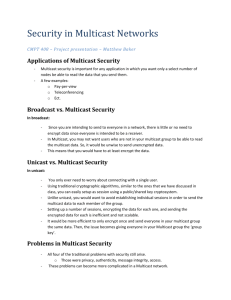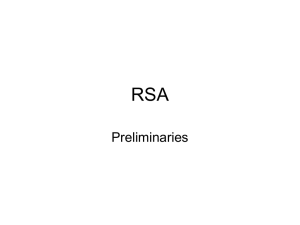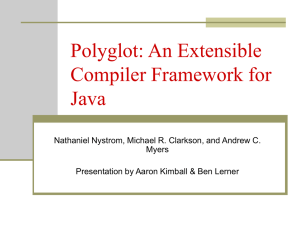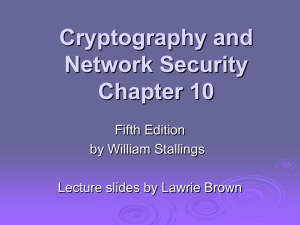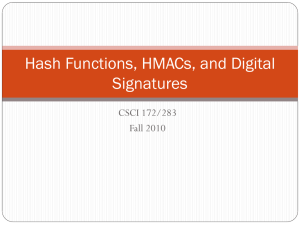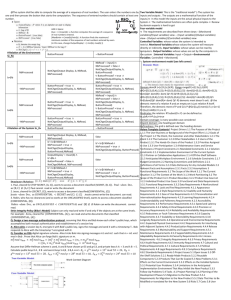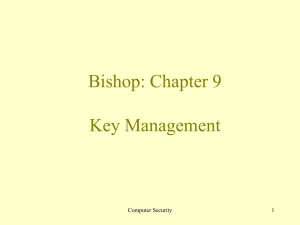Public Key Cryptography
advertisement
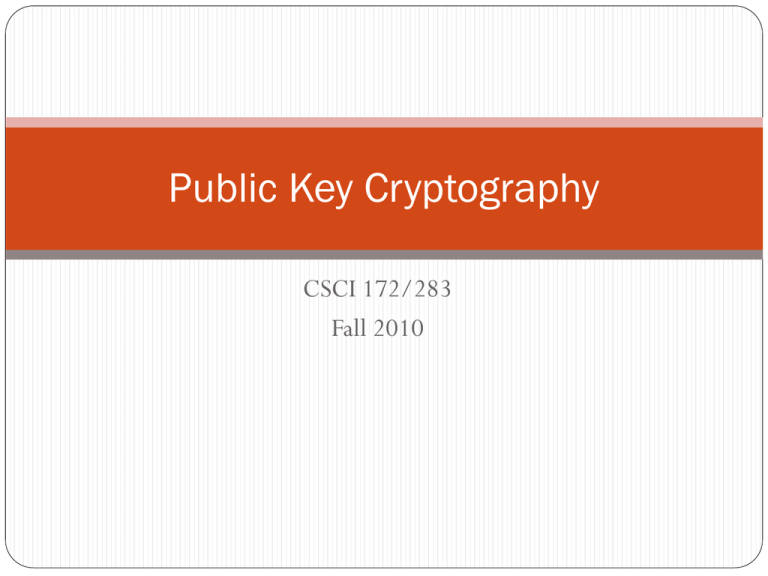
Public Key Cryptography
CSCI 172/283
Fall 2010
Public Key Cryptography
New paradigm introduced by Diffie and Hellman
The mailbox analogy:
Bob has a locked mailbox
Alice can insert a letter into the box, but can’t unlock it to take
mail out
Bob has the key and can take mail out
Encrypt messages to Bob with Bob’s public key
Can freely distribute
Bob decrypts his messages with his private key
Only Bob knows this
Requirements
How should a public key scheme work?
Three main conditions
It must be computationally easy to encrypt or decrypt a
message given the appropriate key
It must be computationally infeasible to derive the private key
from the public key
It must be computationally infeasible to determine the private
key from chosen plaintext attack
Attacker can pick any message, have it encrypted, and obtain the
ciphertext
Exchanging keys
Alice and Bob want to communicate using a block cipher to
encrypt their messages, but don’t have shared key
How do Alice and Bob get a shared key?
Solution 1
Alice sends the key along with her encrypted message
Eve sees encrypted message and key
Uses key to decrypt message
Solution 2
Alice sends the key at some time prior to sending Bob the
encrypted message
Eve has to wait longer
If she saw the key transmission, she has the key
Uses key to decrypt message
Solution 3 – Use public key crypto
Diffie Hellman Key Exchange
All users share common modulus, p, and element g
g ≠ 0, g ≠ 1, and g ≠ p-1
Alice chooses her private key, kA
Computes KA = gkA mod p and sends it to Bob in the clear
Bob chooses his private key, kB
Computes KB = gkB mod p and sends it to Alice in the clear
When Alice and Bob want to agree on a shared key, they
compute a shared secret S
SA,B = KBkA mod p
SB,A = KAkB mod p
Why does DH work?
SA,B = SB,A
(gkA) kB mod p = (gkB) kA mod p
Eve knows
g and p
KA and KB
Why can’t Eve compute the secret?
SA,B = KBkA mod p
SB,A = KAkB mod p
This was the first public key cryptography scheme
Hard problems
Public key cryptosystems are based on hard problems
DH is based on the Discrete Logarithm Problem (DLP)
Given:
Multiplicative group G
Element a in G
Output b
Find:
Unique solution to ax = b in G
x is loga b
No polynomial time algorithm exists to solve this*
*On classical computers
Could it fail?
Eve could fool Alice and Bob
Man in the middle / bucket brigade
My key is KA
Alice
My key is K’B
My key is K’A
My key is KB
Eve
Alice has no guarantee that the person she’s establishing
a key with is actually Bob
Bob
RSA
Rivest-Shamir-Adleman
Probably the most well-known public key scheme
First, some background
Euler’s Totient
Totient function (n)
Number of positive numbers less than n that are relatively
prime to n
Two numbers are relatively prime when their greatest common divisor is
1
Example: (10) = 4
1, 3, 7, 9
Example: (7) = 6
1, 2, 3, 4, 5, 6
If n is prime, (n) = n-1
RSA keys
Choose 2 large primes, p and q
N = pq
(N) = (p-1)(q-1)
Choose e < N such that gcd(e, (N))=1
d such that ed = 1 mod (N)
Public key: {N, e}
Private key: {d}
p and q must also be kept secret
RSA encryption/decryption
Alice wants to send Bob message m
She knows his public key, {N,e}
c = me mod N
m = cd mod N
c
Alice
Bob
Toy example
p=7, q=11
N=77
(N) = (6)(10) = 60
Bob chooses e=17
Uses extended Euclidean algorithm to find inverse of e mod 60
Finds d=53
Bob makes {N, e} public
Toy example (continued)
Alice wants to send Bob “HELLO WORLD”
Represent each letter as a number 00(A) to 25(Z)
26 is a space
Calculates:
0717 mod 77 = 28, 0417 mod 77 = 16, …, 0317 mod 77 = 75
Sends Bob 28 16 44 44 42 38 22 42 19 44 75
He decrypts each number with his private key and gets
“HELLO WORLD”
What could go wrong?
What was wrong with the toy example?
Eve can easily find the encryption of each letter and use that as a
key to Alice’s message
Even without knowing the public key, can use statistics to find
likely messages
Like cryptogram puzzles
How it should really happen
p and q should be at least 512 bits each
N at least 1024 bits
The message “HELLO WORLD” would be converted into
one very large integer
That integer would be raised to the public/private exponent
For short message, pad them with a random string
Is this key yours?
How to bind a key to an identity?
PK Paradigm
Genkey(some info)
Creates Kpub and Kpriv
Encrypt with Kpub
Decrypt with Kpriv
Certificate binds key to individual
IBE
Identity-Based Encryption
Kpub is well-known
Known to be bound to owner
Name, email, SSN, etc.
Owner requests a private key from CA
No certificates required
Conclusion by xkcd
http://xkcd.com/538/


